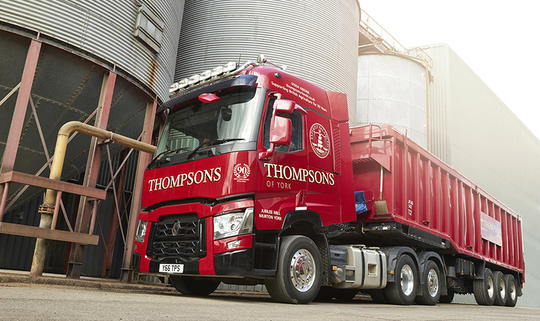
kscarbel2
Moderator-
Posts
18,886 -
Joined
-
Days Won
114
Content Type
Profiles
Forums
Gallery
Events
Blogs
BMT Wiki
Collections
Store
Everything posted by kscarbel2
-
AVL is an Austrian contract designer (you may have heard of UK-based Ricardo, another one). AVL designed the current Ford 6.7L Powerstroke, and does a great deal of (behind the scenes) work for auto and truck makers around the world. https://www.avl.com/ https://en.wikipedia.org/wiki/AVL_(engineering_company)
-
RT / November 21, 2017 French truck drivers have blocked traffic at border crossings with Italy, Belgium, Spain and Germany to protest EU regulations which they say fail to protect their jobs from a cheaper Eastern European workforce. The drivers blocked the Frejus tunnel in Modane before dawn Tuesday, with 200 trucks gathering at the crossing with Italy at some point. The same amount of lorries organized a blockade at the border crossing into Rekkem, Belgium. The protesters let cars pass but prevented access to all trucks, with the traffic jam there stretching some 10 kilometers. Traffic on the main motorway from the French city of Lille to Ghent in Belgium was also disrupted. Similar actions took place at crossings into Germany and Spain, while on the Luxembourg border, truckers drove slow to obstruct traffic. The protests, which lasted for several hours before the trucks cleared the way, were “a warning for Europe,” Pascal Goument of the CFTC union said as cited by AFP. The French truckers are unhappy with the manner in which their president renegotiated the Posted Workers Directive with EU. During talks in October, Emmanuel Macron, reached a compromise with Brussels to cut the time a foreign worker can be posted abroad to 12 months, with a possible half-year extension at the request of the employer. However, under pressure from Poland, Hungary and Spain, the road transport sector wasn’t included in the deal. Five trucker unions demanded a meeting with Macron Tuesday to discuss the issue, saying that French drivers are facing unfair competition from their cheaper EU colleagues, who pay taxes and social charges at home and cope without free meals and lodging. “Widening gaps in pay and conditions endanger French firms and workers,” Pascal Favre of the FO union told Reuters. “[There are] those who work for lower pay because they spend more time behind the wheel on jobs the French do not do because of unfair competition,” he said. French drivers demand "equal work for equal pay – right now, not in 10 years," thundered Patrick Blaise of the CFDT union. Antoine Fatiga of the CGT union said, "We don't want drivers to be slaves on the road.” When drivers from Poland, Hungary and elsewhere “come to work here for two times less than us, we struggle to keep our work." .
-
Particularly compared with the problematic 6.0-litre Powerstroke (Navistar VT365 with HEUI fuel injection), the current AVL-designed 6.7 has delivered good service for most operators. That said, I'd rather have the 6.7L Cummins ISB. As I said before, if one could order a Ford pickup with the Cummins ISB and Allison 1000 Series transmission, you'd be good to go.
-
They do. Jim, you should go to the IAA commercial truck show in Hannover, Germany next year. You'd be shocked.
-
Commercial Motor / November 21, 2017 Animal feed provider Thompsons of York has taken delivery of its first trucks from Renault - three high specification Renault Range T520.26 6x2 tag axle tractor units with sleeper cabs. The vehicles, supplied by Thompson Commercials (Hull), come with Alcoa aluminium wheels, 24-litre fridges, Kelsa top light bars with six spot lights, leather steering wheels and leather Recaro seats. They will pull Fruehauf triaxle tipping trailers with Priden/Alibulk auxiliary equipment and make bulk agricultural deliveries to farms within a 100-mile radius. Transport manager, SteveRoom, said: “The delivery of raw materials into Thompsons is outsourced, and from big fleets to one-man bands, all of those operators with Renault trucks spoke highly of them and would get another one. "Some of these men are what I would call ‘very hard to please’ so if they’re happy with Renault Trucks then they must be good.” Room said reliability and first-class dealer back-up are key factors for Thompsons of York when buying new vehicles. “The Thompson Commercials salesman, Dale Arnott, is very good and easy to get on with; he gives the strong impression that he cares, which makes a lot of difference”, he said. “Most of our drops would be okay with a mid-lift, but I went for a tag axle as it gives more manoeuvrability and grip and gets into places easier than a standard tractor unit. This is especially important when going in and out of farmland that has more challenging muddy ground.” .
-
Scania Group Press Release / November 21, 2017 Scania Top Team is back! The competition to find the best service technicians in the Scania network is under way again. Between now and December 2018, service technicians from all over the world will put their practical and theoretical skills to the test in national, regional and world finals. Top Team has come a long way since its start in 1989. At first it was a purely Swedish event, but soon the competition captured the imagination of other Nordic countries; later it spread into the rest of Europe, and in recent years it has become a truly global challenge. One man who is as excited as any of the 2017/18 competitors is Harald Cederberg, Director for Technical Training at the ScaniaAcademy. As head of the Top Team jury, Cederberg has followed the competition’s development through the years. 8,000 competitors Cederberg first became involved with Top Team in 2003. Since then he has seen it grow to an event comprising 8,000 competitors from 70 countries, grouped into Europe, Asia/Oceania and Latin America/Africa. “The event benefits Scania in two ways,” he says. “It’s about the teams being able to build up their competencies as service technicians, and it’s about building the Scania brand so we can attract new talent.” It also gives some well-deserved attention to some unsung heroes in the Scania network. “Part of this is to shine a light on the service technicians, as they are core to the service organization,” Cederberg says. “These are the people who meet the customer and add value to the customer every day.” .
-
That is a nice looking dump (tipper) body.
-
In this photo, you can see the new H62X cab is a genuine "full-width" European level cab. H62X represents very serious intentions and investment on Ford's part. Well done. .
-
Critics push U.S. to help Europe by taking more refugees
kscarbel2 replied to kscarbel2's topic in Odds and Ends
US ending temporary permits for 60,000 Haitians Associated Press / November 21, 2017 WASHINGTON — The Trump administration said Monday it is ending a temporary residency permit program that has allowed almost 60,000 citizens from Haiti to live and work in the United States since a 2010 powerful earthquake shook the Caribbean nation. The Homeland Security Department said conditions in Haiti have improved significantly, so the benefit will be extended one last time — until July 2019 — to give Haitians time to prepare to return home. "Since the 2010 earthquake, the number of displaced people in Haiti has decreased by 97 percent," the department said. "Haiti is able to safely receive traditional levels of returned citizens." Advocates and members of Congress from both parties had asked the Trump administration for an 18-month extension of the program, known as Temporary Protected Status. Haitian President Jovenel Moise's government also requested the extension. While Haiti has made advances spurred by international aid since the quake, the Caribbean nation remains one of the poorest in the world. More than 2.5 million people, roughly a quarter of the population, live on less than $1.23 a day, which authorities there consider extreme poverty [Not our problem....life is what you make it]. The United Nations last month ended a peacekeeping mission in Haiti that, at its peak, included more than 10,000 troops. Its new mission is comprised of about 1,300 international civilian police officers and 350 civilians who will help the country try to reform a deeply troubled justice system. The Homeland Security Department made its announcement 60 days before temporary status for the Haitians is set to expire. In May, the agency extended the program for only six months instead of the customary 18, and urged Haitians under the program to get their affairs in order and prepare to go home. The temporary status covers some 435,000 people from nine countries effected by natural disasters or war, who came to the U.S. legally or otherwise. Days after a 7.0-magnitude earthquake hit Haiti in January 2010, President Obama granted the 18-month protection status for Haitians in America who would otherwise have to go home. Obama renewed it every time it ran out. Monday's decision doesn't affect thousands of Haitians who were taken in by Brazil and other South American countries after the earthquake and began making their way to the United States last year. U.S. Customs and Border Protection says 6,424 Haitians showed up at border crossings with Mexico during the 12-month period ended Sept. 30, up from only 334 a year earlier. They were generally paroled to live in the United States on humanitarian grounds [Throwing established immigration policy to the curb]. Since taking office, Trump has ended temporary permit programs for Sudan and Nicaragua. Trump has postponed until next July a decision on how to deal with a similar program for 86,000 residents from Honduras. Maryland Senators Ben Cardin and Chris Van Hollen, along with fellow Democrat Dianne Feinstein of California, last week unveiled new legislation to protect undocumented [illegal] immigrants living under temporary protected status. It would make immigrants under the program eligible to apply for legal permanent residency after three years. -
Tesla receives orders from four companies for electric truck Neil Abt, Fleet Owner / November 18, 2017 At least four companies have publicly confirmed having placed preorders for Tesla’s heavy-duty electric truck. The companies, J.B. Hunt Transport Services, Walmart, Meijer Inc., and Loblaw have each paid the $5,000-a-truck deposit price for the trucks Tesla CEO Elon Musk said will be ready in 2019. J.B. Hunt said in a statement it has reserved “multiple” trucks and plans to deploy them on the West Coast within its Intermodal and Dedicated Contract Services units. “Reserving Tesla trucks marks an important step in our efforts to implement industry-changing technology,” said John Roberts, president and CEO. “We believe electric trucks will be most beneficial on local and dray routes, and we look forward to utilizing this new, sustainable technology.” Walmart said it preordered 15 of the Tesla Semis, with five for its U.S. operations and the other 10 for Canada. "We are excited to be among the first to pilot this new heavy-duty electric vehicle," the company said in a statement to CNBC. Canadian grocery chain Loblaw Cos. told Reuters it had placed an order for 25 of the trucks. The company has intentions of transitioning to a completely electric vehicle fleet by 2030. Another grocer and discount retailer, Meijer Inc., told Bloomberg News it would test four Tesla Semis. The company current has a fleet of 250 trucks. Ryder System told the Wall Street Journal it will place an initial order with Tesla, but did not disclose details. While these firms received immediately publicity for these orders, executives with Hirschbach Motor Lines and Daseke Inc. have said the 500-mile range on a single charge would prevent it from considering the trucks at this early stage.
-
That.....is very painful to look at. The former CAT truck designers and Tonka would be impressed though.
-
Conspiracy theorists can rest at ease. You were right all along. Competing with the R/U/DM design proposal was the B Model II concept, seen here undergoing grueling endurance testing at the former Mack Trucks Engineering, Development & Test Center. This would have been the Mack vocational chassis for the 1970s, 80s and mid-90s. .
-
Note the seat is a Grammer. Not a cheap seat. Grammer and Recaro are the two leading global truck seat manufacturers. Grammer is standard-fit in North American Paccar trucks.
-
Ford Trucks Press Release / November 20, 2017 The seat in your Ford Cargo truck is designed to comfortably support you at all times. Ford Trucks and You – "Sharing the Load" At Ford Trucks, we’re serious about trucking. It's why we designed the new 2017 Cargo heavy truck range from the ground up to meet your needs and expectations. See your authorized Ford heavy truck dealer for details. .
-
Ford Trucks Press Release / November 20, 2017 With standard Ford engine braking, ABS-EBS and an optional retarder, you can safely control your vehicle with industry-leading braking performance. Ford Trucks and You – "Sharing the Load" At Ford Trucks, we’re serious about trucking. It's why we designed the new 2017 Cargo heavy truck range from the ground up to meet your needs and expectations. See your authorized Ford heavy truck dealer for details. .
-
Ford Trucks Press Release / November 20, 2017 You don't need to pull over and check your oil level the old fashioned way with a dipstick. Instead, Ford Cargo electronically performs the oil level measurement through a sensor in the motor. Ford Trucks and You – "Sharing the Load" At Ford Trucks, we’re serious about trucking. It's why we designed the new 2017 Cargo heavy truck range from the ground up to meet your needs and expectations. See your authorized Ford heavy truck dealer for details. .
-
DAF.....spectacular trucks. Ask the man who owns one.
-
DAF Trucks Press Release / November 20, 2017 We’ve introduced a whole range of improvements to increase your return per kilometre and reduce your environmental impact. The New CF and XF set a new standard in transport efficiency and are the benchmark for driver comfort. In short: Pure Excellence. Learn more: http://www.daf.com/en/products/the-new-cf-and-xf .
-
Critics push U.S. to help Europe by taking more refugees
kscarbel2 replied to kscarbel2's topic in Odds and Ends
Israel to shut migrant centre and deport Africans AFP / November 18, 2017 Jerusalem - Israel's cabinet voted on Sunday to close a migrant detention centre, as Prime Minister Benjamin Netanyahu announced an agreement to deport 40,000 Africans who entered the country illegally. Ministers unanimously approved plans to shutter the Holot centre in southern Israel and gave migrants a three-month deadline to leave the country or face deportation, said the interior and public security ministries. "The infiltrators will have the option to be imprisoned or leave the country," the public security ministry said in a statement. Israeli official figures from June 30 show a total of 38,043 African migrants in the country. They include 27,494 Eritreans and 7,869 Sudanese, and their presence in south Tel Aviv has raised discontent among Israelis there and elsewhere. Speaking ahead of Sunday's vote, Netanyahu noted that after building a fence on the Egyptian border and deporting some 20,000 African migrants through various deals, Israel has reached the third stage of its efforts -- "accelerated removal". "This removal is taking place thanks to an international agreement I reached that enables us to remove the 40,000 infiltrators remaining, remove them without their consent," he told ministers. "This will enable us to close down Holot and allocate some of the large funds going there to inspectors and removing more people," said Netanyahu. Holot, an open facility in the desert that can host 1,200 migrants who are allowed to leave to work during the day, would be closed three months from December 16, according to the decision. A public security ministry spokesman said an extension to that deadline would be set if necessary. Ahead of the vote, Public Security Minister Gilad Erdan said Holot had become "a hotel for infiltrators at the tax-payers' expense that does not encourage their exit" and costs 240 million shekels ($68 million, 58 million euros) a year. In a Twitter statement, Erdan however stressed the closure of Holot was conditioned on "us seeing that the policy of removing infiltrators to a third country was indeed taking place." Neither Erdan nor Netanyahu gave details about the deal and the third country. Israel tacitly recognises the Sudanese and Eritreans cannot be returned to their dangerous homelands, so it has signed deals with Rwanda and Uganda, which agree to accept departing migrants on condition they consent to the arrangement, according to activists. -
I suggest you call Watt's Mack at 1-888-304-6225 and ask on availability of a new, low-cost (Bostrom or National) silver-gray vinyl high-back seat. See what did they say.
-
How should I say this........I don't want our government to control human conscience. But the government is in a superb position to inspire positive behavior and cultural development. Look at how former Mack Trucks CEO Zenon Hansen inspired everyone (and I mean everyone!) at Mack Trucks, for example. He inspired us all to be great Americans, be proud of Mack Trucks and reach our full potential. His entire attitude stemmed from his Scouting background. Zenon had a hard childhood, and he found a life direction with Scouting. He was an Eagle Scout. "A Scout is Trustworthy, Loyal, Helpful, Friendly, Courteous, Kind, Obedient, Cheerful, Thrifty, Brave, Clean and Reverent." People inspired with these values contribute to their families, their company and country, and society in general. Today, a huge percentage of the masses are, apparently, incapable of steering their behavioral development in a good direction. Done properly, the government is in the best position to inspire. Look at Teddy Roosevelt, FDR and JFK......they each inspired a generation. That all said, we haven't enjoyed good, effective government since Eisenhower.
BigMackTrucks.com
BigMackTrucks.com is a support forum for antique, classic and modern Mack Trucks! The forum is owned and maintained by Watt's Truck Center, Inc. an independent, full service Mack dealer. The forums are not affiliated with Mack Trucks, Inc.
Our Vendors and Advertisers
Thank you for your support!





.jpg.e1ebf3a851ad42b9bf9177b785fb758c.jpg)







